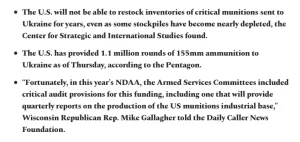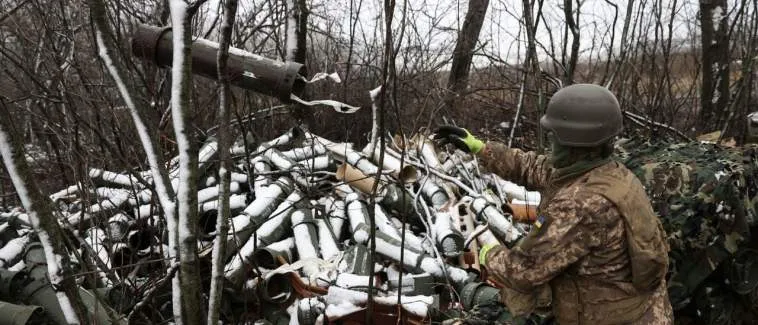
(Daily Caller) Even at emergency production rates, it will take several years before the U.S. is able to restock supplies of critical munitions sent to Ukraine, according to a recent analysis conducted by the Center for Strategic and International Studies (CSIS), a Washington, D.C. based think tank.
The U.S. has sent millions of rounds of ammunition of various kinds to Ukraine, according to a Thursday fact sheet from the Department of Defense (DOD), which has resulted in severe deficits in some cases. Only one of the six weapons where stockpiles have fallen dangerously low is projected to reach normal levels within five years, assuming no further deliveries to Ukraine, leaving the U.S. scrambling for alternatives, Mark Cancian, a former artillery officer and Pentagon acquisition official, found in a report published in CSIS.
“Longer term, there will be some competition between Taiwan’s needs and rebuilding US stockpiles,” Cancian told the Daily Caller News Foundation, as the U.S. pledges to help the island fend off Chinese aggression. “That’s why increased munitions production is so important.”
“Most inventories, though not all, will take many years to replace. For most items, there are workarounds, but there may be a crisis brewing over artillery ammunition,” Cancian wrote.
For example, the U.S. has provided 1.1 million rounds of 155mm ammunition, a widely-used explosive shell, to Ukraine since Russia’s invasion on Feb. 24, 2022, the fact sheet shows.
At the regular production rate of 93,000 rounds annually, the industrial base would never be able to replenish 155mm projectiles because of the number consumed in standard military training and maintenance operations, the CSIS report said. The base can surge to a rate of 240,000 rounds each year, but even then it would take five years before inventories of 155mm would be fully rebuilt.
Defense Secretary Lloyd Austin pledged in May that DOD will not allow domestic inventories of “critical” munitions to fall below minimum levels needed for national security, according to Defense News. Pentagon deputy press secretary Sabrina Singh repeated that promise on Thursday.
Army acquisition czar Doug Bush said in September the service planned to triple 155mm production over the next “couple” of years with support from Congress, Task and Purpose reported. The Army held an “Industry Day” on Tuesday to provide arms manufacturing companies with an overview of the army’s requirements for accelerating production of 155mm projectiles and the need to expand production capacity, a notice shows.
The U.S. has pulled hundreds of thousands of the 155mm shells from stockpiles operated by U.S. military units in Israel and routed them to Ukraine. Additional equipment of an unspecified nature may be transferred out of U.S. forces in Korea, Reuters reported Thursday.
“The Ukrainians will never run out of ammunition,” Cancian told the Daily Caller News Foundation. Supply for lighter weapons, like rifles and machine guns, could continue indefinitely, but “artillery ammunition,” the foundation of ground warfare, “has been the most difficult,” he added.
To make up for shortages, the U.S. has begun substituting some weapons that may be slightly less appropriate to the type of warfare Ukraine is conducting and buyingartillery from other countries, Cancian explained to the DCNF.
GPS-guided 155 mm munitions are also at risk, according to the analysis. Recent production rates of 1,000 per year mean it could take seven years to refill U.S. inventories, or four years at an accelerated production rate.
At the recent rate of production, it will take eight years to replenish U.S. stocks of Javelins; surge production rates could shorten the timeline to five and one-half years, according to the CSIS analysis. Javelin stocks have become so strained that DOD suspended further deliveries to Ukraine to avoid undercutting plans for dealing with possible conflicts elsewhere.
Stinger missiles could take even longer, up to 18 years, corresponding with decreasing demand within DOD for the munition.
Cancian predicted the inventory of High Mobility Artillery Rockets System (HIMARS) could be restocked within three years. However, part of the reason for the more comfortable production margin is that the U.S. has donated so few — just 20 as of Jan. 6 — relative to Ukraine’s needs, Cancian wrote.
Thursday’s defense package did not include any additional HIMARS, Stingers or Javelins, according to a release.
Are U.S. weapons inventories getting too low because of transfers to Ukraine? Although most inventories are acceptable, some key munitions will take many years to replace, writes @csis_isp expert Mark F. Cancian.
Learn more: https://t.co/YMM3yZ1GQi pic.twitter.com/M2lEgm0oeE
— CSIS (@CSIS) January 12, 2023
Meanwhile, Ukraine is firing artillery at a rate of roughly 90,000 rounds per month, officials told The New York Times in November.






